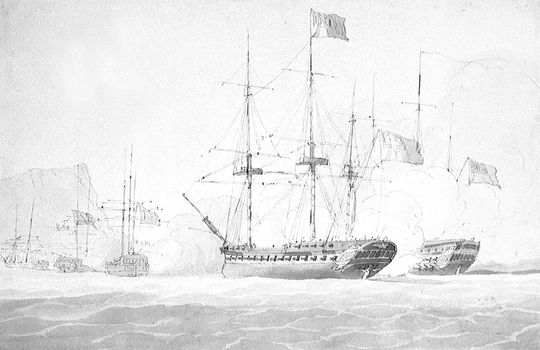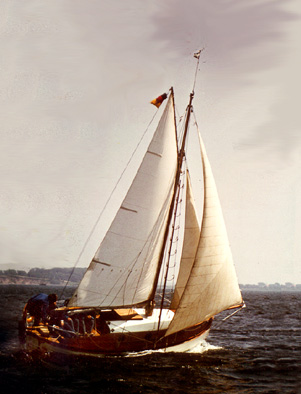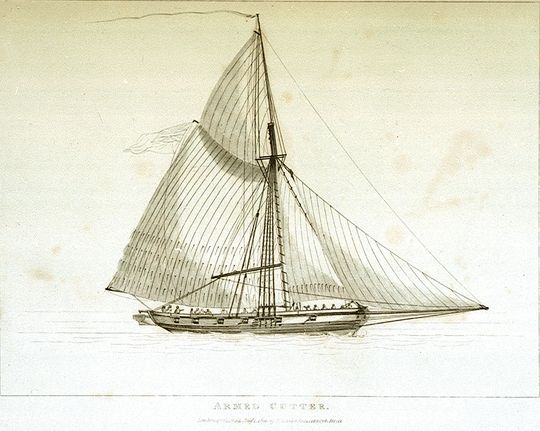|
HMS Capelin (1804)
HMS ''Capelin'' was a Royal Navy ''Ballahoo''-class schooner carrying four 12-pounder carronades and a crew of 20. The prime contractor for the vessel was Goodrich & Co., in Bermuda, and she was launched in 1804. Like many of her class and the related ''Cuckoo''-class schooners, she succumbed to the perils of the sea relatively early in her career. Career In May 1804 she was commissioned under Lieutenant Archibald McDonald (or M'Donald; acting) for the Halifax station. On 20 December 1806 he faced a court martial for his conduct after ''Capelin'' had run aground while under his command. The court decided that the charge was partly proven and so reprimanded him. It also ruled that he forfeit all seniority on the lieutenants' list. Still, McDonald was promoted to lieutenant on 22 December 1806 and commanded ''Capelin'' until February 1807. At some point, possibly in 1806, Lieutenant J. Beckett may have commanded her for a short period. In 1807 ''Capelin'' was off Le Havre and un ... [...More Info...] [...Related Items...] OR: [Wikipedia] [Google] [Baidu] |
United Kingdom Of Great Britain And Ireland
The United Kingdom of Great Britain and Ireland was a sovereign state in the British Isles that existed between 1801 and 1922, when it included all of Ireland. It was established by the Acts of Union 1800, which merged the Kingdom of Great Britain and the Kingdom of Ireland into a unified state. The establishment of the Irish Free State in 1922 led to the remainder later being renamed the United Kingdom of Great Britain and Northern Ireland in 1927. The United Kingdom, having financed the European coalition that defeated France during the Napoleonic Wars, developed a large Royal Navy that enabled the British Empire to become the foremost world power for the next century. For nearly a century from the final defeat of Napoleon following the Battle of Waterloo to the outbreak of World War I, Britain was almost continuously at peace with Great Powers. The most notable exception was the Crimean War with the Russian Empire, in which actual hostilities were relatively ... [...More Info...] [...Related Items...] OR: [Wikipedia] [Google] [Baidu] |
French Frigate Sibylle (1792)
''Sibylle'' was a 38-gun of the French Navy. She was launched in 1791 at the dockyards in Toulon and placed in service in 1792. After the 50-gun fourth rate captured her in 1794, the British took her into service as HMS ''Sybille''. She served in the Royal Navy until disposed of in 1833. While in British service ''Sybille'' participated in three notable single ship actions, in each case capturing a French vessel. On anti-slavery duties off West Africa from July 1827 to June 1830, ''Sybille'' captured numerous slavers and freed some 3,500 slaves. She was finally sold in 1833 in Portsmouth. French service From 23 April 1790 to October–December 1792, ''Sibylle'' escorted a convoy and transferred funds from Toulon to Smyrna, first under Capitaine de vaisseau (CV) Grasse-Briançon and then CV de Venel. From March 1793 to January 1794, under CV Rondeau, she escorted convoys between Toulon and Marseilles and then she moved to the Levant station. She cruised the Aegean Sea, and in ... [...More Info...] [...Related Items...] OR: [Wikipedia] [Google] [Baidu] |
Ships Built In Bermuda
A ship is a large watercraft that travels the world's oceans and other sufficiently deep waterways, carrying cargo or passengers, or in support of specialized missions, such as defense, research, and fishing. Ships are generally distinguished from boats, based on size, shape, load capacity, and purpose. Ships have supported exploration, trade, warfare, migration, colonization, and science. After the 15th century, new crops that had come from and to the Americas via the European seafarers significantly contributed to world population growth. Ship transport is responsible for the largest portion of world commerce. The word ''ship'' has meant, depending on the era and the context, either just a large vessel or specifically a ship-rigged sailing ship with three or more masts, each of which is square-rigged. As of 2016, there were more than 49,000 merchant ships, totaling almost 1.8 billion dead weight tons. Of these 28% were oil tankers, 43% were bulk carriers, and 13% were cont ... [...More Info...] [...Related Items...] OR: [Wikipedia] [Google] [Baidu] |
1804 Ships
Eighteen or 18 may refer to: * 18 (number), the natural number following 17 and preceding 19 * one of the years 18 BC, AD 18, 1918, 2018 Film, television and entertainment * ''18'' (film), a 1993 Taiwanese experimental film based on the short story ''God's Dice'' * ''Eighteen'' (film), a 2005 Canadian dramatic feature film * 18 (British Board of Film Classification), a film rating in the United Kingdom, also used in Ireland by the Irish Film Classification Office * 18 (''Dragon Ball''), a character in the ''Dragon Ball'' franchise * "Eighteen", a 2006 episode of the animated television series '' 12 oz. Mouse'' Music Albums * ''18'' (Moby album), 2002 * ''18'' (Nana Kitade album), 2005 * '' 18...'', 2009 debut album by G.E.M. Songs * "18" (5 Seconds of Summer song), from their 2014 eponymous debut album * "18" (One Direction song), from their 2014 studio album ''Four'' * "18", by Anarbor from their 2013 studio album ''Burnout'' * "I'm Eighteen", by Alice Cooper common ... [...More Info...] [...Related Items...] OR: [Wikipedia] [Google] [Baidu] |
Pointe Saint-Mathieu
The pointe Saint-Mathieu (Lok Mazé in Breton) is a headland located near Le Conquet in the territory of the commune of Plougonvelin in France, flanked by 20m high cliffs. Village At present, there are only a few houses on the point, grouped around the abbey ruins. However, in the past the settlement was not limited to the abbey and its dependents. Very soon a village was established along the coast for commercial potential and the possibilities for salvaging wrecks. Abbey The abbey held many privileges - right to rushes, right to furnaces, rights to a twelfth of jet, right to markets, right to fairs (Henry IV of France had instituted, in 1602, 5 annual fairs and a weekly market), right to measure wheat and wine, etc... In 1157 Hervé de Léon accorded the abbey the right of flotsam and jetsam on wrecks in all his fiefdoms; in 1390 the abbey received the right to take 10% of the hull, cargo and rigging of wrecked ships. To this right were added the right of remains, confirmed i ... [...More Info...] [...Related Items...] OR: [Wikipedia] [Google] [Baidu] |
Hired Armed Cutter Adrian
Two vessels named His Majesty's Hired armed cutter ''Adrian'' served the British Royal Navy during the Napoleonic Wars as hired armed vessels. First ''Adrian'' The first ''Adrian'' was the cutter ''Industry'', of 84 tons (bm). She was armed with eight 12-pounder carronades. She served under contract from 21 August 1804 to 25 August 1805. During her service she was renamed ''Adrian''. ''Adrian'' was in company with the frigate when on 1 and 2 June 1805 ''Adrian'' captured the chasse-marées ''Marie'' and ''Sophie''. At the time ''Adrian'' was under the command of Lieutenant Joseph Bain Bett, who apparently transferred from the hired armed cutter ''Rhoda''. ''Marie'' was one of three chasse-marées that on 1 June he observed sailing to Brest. ''Adrian'' succeeded in first driving ''Marie'' ashore, and then capturing her. However, as the prize crew was retrieving her, a musket ball killed ''Adrian''s mate. ''Marie'' had been carrying a cargo of wine and brandy from Bordeaux to Brest ... [...More Info...] [...Related Items...] OR: [Wikipedia] [Google] [Baidu] |
Cutter (boat)
A cutter is a type of watercraft. The term has several meanings. It can apply to the rig (or Sail plan, sailplan) of a sailing vessel (but with regional differences in definition), to a governmental enforcement agency vessel (such as a coast guard or border force cutter), to a type of ship's boat which can be used under sail or oars, or, historically, to a type of fast-sailing vessel introduced in the 18th century, some of which were used as small warships. As a sailing rig, a cutter is a single-masted boat, with two or more headsails. On the eastern side of the Atlantic Ocean, Atlantic, the two headsails on a single mast is the fullest extent of the modern definition. In U.S. waters, a greater level of complexity applies, with the placement of the mast and the rigging details of the bowsprit taken into account so a boat with two headsails may be classed as a sloop. Government agencies use the term "cutter" for vessels employed in patrolling their territorial waters and other ... [...More Info...] [...Related Items...] OR: [Wikipedia] [Google] [Baidu] |
Hired Armed Vessels
During the eighteenth and nineteenth centuries the Royal Navy made use of a considerable number of hired armed vessels. These were generally smaller vessels, often cutters and luggers, that the Navy used for duties ranging from carrying and passengers to convoy escort, particularly in British coastal waters, and reconnaissance.Winfield (2008), p.387. Doctrine The Navy Board usually hired the vessel complete with master and crew rather than bareboat. Contracts were for a specified time or on an open-ended monthly hire basis. During periods of peace, such as the period between the Treaty of Amiens and the commencement of the Napoleonic Wars, the Admiralty returned the vessels to their owners, only to rehire many on the outbreak of war. The Admiralty provided a regular naval officer, usually a lieutenant for the small vessels, to be the commander. The civilian master then served as the sailing master. For purposes of prize money or salvage, hired armed vessels received the sa ... [...More Info...] [...Related Items...] OR: [Wikipedia] [Google] [Baidu] |
Brest, France
Brest (; ) is a port city in the Finistère department, Brittany. Located in a sheltered bay not far from the western tip of the peninsula, and the western extremity of metropolitan France, Brest is an important harbour and the second French military port after Toulon. The city is located on the western edge of continental France. With 142,722 inhabitants in a 2007 census, Brest forms Western Brittany's largest metropolitan area (with a population of 300,300 in total), ranking third behind only Nantes and Rennes in the whole of historic Brittany, and the 19th most populous city in France; moreover, Brest provides services to the one million inhabitants of Western Brittany. Although Brest is by far the largest city in Finistère, the ''préfecture'' (regional capital) of the department is the much smaller Quimper. During the Middle Ages, the history of Brest was the history of its castle. Then Richelieu made it a military harbour in 1631. Brest grew around its arsenal un ... [...More Info...] [...Related Items...] OR: [Wikipedia] [Google] [Baidu] |
HMS Champion (1779)
Five ships of the Royal Navy have borne the name HMS ''Champion'': * was a 24-gun sixth rate launched in 1779. She was reassigned to harbour service in 1810 and sold in 1816. * was an 18-gun sloop launched in 1824. She was reassigned to harbour service in 1859 and broken up in 1867 after being wrecked as a target. * was a screw corvette launched in 1878. She was reassigned to harbour service in 1904 and was renamed ''Champion (old)'' in 1915 to free the name for the next ''Champion'' under construction. She was sold in 1919. * was a light cruiser launched in 1915. She served during the First World War and was present at the Battle of Jutland The Battle of Jutland (german: Skagerrakschlacht, the Battle of the Skagerrak) was a naval battle fought between Britain's Royal Navy Grand Fleet, under Admiral Sir John Jellicoe, and the Imperial German Navy's High Seas Fleet, under Vic ..., before being sold in 1934. * HMS ''Champion'' was a planned destroyer, but was ... [...More Info...] [...Related Items...] OR: [Wikipedia] [Google] [Baidu] |
Naval Ensign Of The United Kingdom
The White Ensign, at one time called the St George's Ensign due to the simultaneous existence of a cross-less version of the flag, is an ensign worn on British Royal Navy ships and shore establishments. It consists of a red St George's Cross on a white field, identical to the flag of England except with the Union Flag in the upper canton. The White Ensign is also worn by yachts of members of the Royal Yacht Squadron and by ships of Trinity House escorting the reigning monarch. In addition to the United Kingdom, several other nations have variants of the White Ensign with their own national flags in the canton, with the St George's Cross sometimes being replaced by a naval badge omitting the cross altogether. Yachts of the Royal Irish Yacht Club wear a white ensign with an Irish tricolour in the first quadrant and defaced by the crowned harp from the Heraldic Badge of Ireland. The Flag of the British Antarctic Territory and the Commissioners' flag of the Northern Lig ... [...More Info...] [...Related Items...] OR: [Wikipedia] [Google] [Baidu] |




